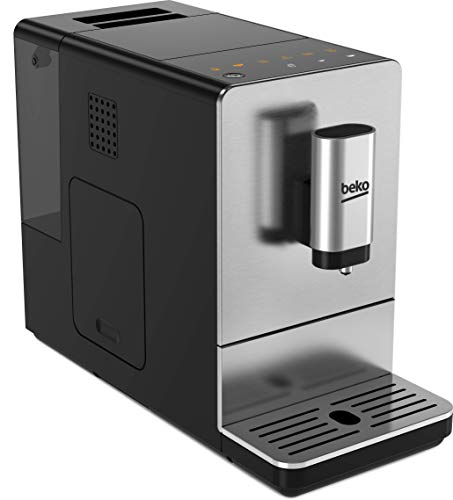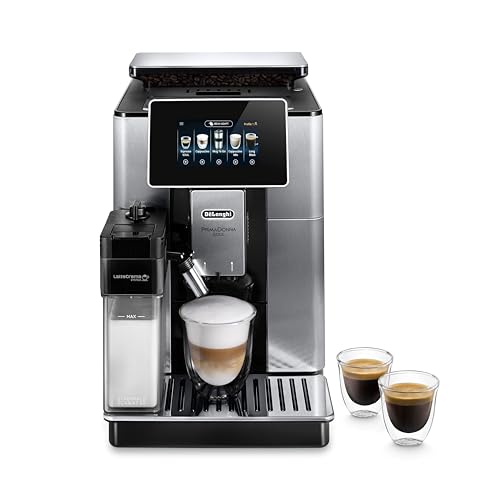Are Coffee Bean Coffee Machine The Greatest Thing There Ever Was?
페이지 정보
작성자 Abe 작성일 25-01-04 14:08 조회 2 댓글 0본문
 Bean-to-Cup Coffee Machines
Bean-to-Cup Coffee MachinesBean-to-cup machines are ideal for those mornings where you're exhausted and need to press a button. They also offer a degree of flexibility for more adventurous drinkers.
 They are able to store whole beans in a hopper and then grinding them prior to brewing and pouring drinks at the click of a button. They can serve both staff and customers, with out the requirement for a barista.
They are able to store whole beans in a hopper and then grinding them prior to brewing and pouring drinks at the click of a button. They can serve both staff and customers, with out the requirement for a barista.Cost-effectiveness
Each coffee pod has its pros and cons, no matter if you prefer the traditional flavor or convenience of pre-packaged pods. Cost-effectiveness is the most important aspect. Bean-to-cup machines are a more economical option for long-term use than pod-based models. You can save on recurring costs by buying high-quality, bulk beans for less than pods. They also help reduce the amount of waste produced by removing coffee pods.
Bean-to-cup coffee makers are perfect for office environments, as they are easy to use. Contrary to manual drip coffee makers that require the user to grind beans and prepare them manually, bean-to-cup machines provide an even, smooth coffee at the touch of the button. They are also designed to be low-maintenance, and easy to clean. Many come with built-in rinse programs and cleaning programs, making it simple to ensure that they run smoothly.
The primary advantage of a machine that beans to cups is its user-friendliness. It is generally easy to set up and use, and requires no previous training to operate. It comes with a built-in milk grinder and frother. This makes it perfect for small businesses with a only a few employees. Moreover, it provides premium coffee at the click of a button, which is especially ideal for offices that are busy.
While it is more expensive to buy a bean-to-cup machine than a pod model, it will save money over the long term by reducing the cost of equipment and energy consumption. Moreover, it is environmentally more sustainable than pod-based machines as it generates less waste and uses fewer natural resources.
Coffee can be a fantastic way to boost morale and increase productivity. By offering a bean-to-cup machine in the breakroom and creating an environment that fosters collaboration and teamwork. Additionally it will encourage interaction between your employees through informal conversations. In these discussions employees can share their thoughts and come up with creative solutions to problems. Moreover, a quick cup of coffee can give your brain a mental stimulation and spark imagination.
Convenience
Bean-to-cup coffee machines are a cost-effective method to provide premium coffee at the push of the button. They are easy-to-use and require minimal maintenance. They also feature built-in grinders to ensure that your beans are freshly roasted for each cup. They can also be programmed to produce a variety of different drinks with the click of a button, such as cold and hot beverages. You can make a vast range of drinks to serve your staff and customers.
A bean-to-cup coffee maker will also save you money by avoiding the need for paper filters and plastic cups. It also reduces the amount of coffee grounds that end in the trash. If you're an environmentally conscious person, you can make use of a coffee machine that uses organic whole beans for a more sustainable experience.
Unlike pod coffee machines, that require a certain level of proficiency to operate, a bean-to-cup machine can be operated by anyone who has little or no knowledge. The user only needs to fill the bean hopper and the water tank prior to selecting the desired drink from the machine's easy-to-use control panel. Certain coffee bean machines allow you to alter the temperature and strength.
While pod coffee machines use pre-ground coffee powder, the bean to cup coffee bean to cup machine machine grinds whole beans prior to brewing every cup of coffee. This keeps the aroma and flavor of the beans and results in a more authentic taste and texture. They can also customize each cup of espresso to the user by analyzing their preferences over time. Barista Smart is a good example of a machine that does this. It can be programmed to work with 21 different types of coffee, from espresso to black coffee.
A bean-to cup coffee machine will also run a wash cycle before it turns off and when it is first turned on. This will prevent the build-up of residues on the coffee spouts, or milk dispenser. It also has an internal bin for milk and coffee grounds that are used up. The bin doesn't have to be cleaned each day and is usually equipped with a visual reminder that it is full.
Freshness
Fresh-brewed coffee is not only delicious however, it also has a variety of health benefits. It can boost metabolism, decrease the risk of heart disease and provide an unnatural energy boost. It is important to select the best beans for your machine. Choose whole bean to cup coffee machine for home coffees with clearly marked roast dates to ensure the best quality and taste for your coffee. This is essential for bean-to cup machines which require freshly roasted pre-ground coffee beans. The use of coffee beans that are old can result in poor flavor and a bitter, unpleasant taste.
The shelf life of coffee beans is contingent on several factors, including storage conditions and temperature. Unopened bags of whole beans can be stored for up to six months following roasting if properly stored. But once the beans are ground, their shelf life decreases significantly due to the larger surface area which exposes them to oxygen. It is generally recommended to use beans freshly ground within two weeks after opening or grinding.
Another method to determine if your coffee is fresh is by inspecting the appearance of the beans. fresh espresso beans whole beans will be shiny, while older coffee beans appear dull and dried. You can also gauge the freshness of the beans by smelling them.
When coffee beans are roast, they release volatile aromatic oils that imparts the flavor of the bean. These oils are responsible for the distinct flavor of each coffee and if they lose their potency, the taste of the coffee brewed will suffer. To avoid this, make sure you purchase coffee beans with an exact roasting date. keep them in a sealed airtight container.
It is also recommended that you grind the coffee for a few days prior to the brewing. This will minimize the oxidation process and ensure that you enjoy the best bean to cup espresso machine flavor you can get. To get the best results, avoid storing roasted coffee beans to cup (sneak a peek at this web-site.) in the freezer, which can cause structural damage and the accumulation of moisture.
The hopper is a crucial component of any bean to cup machine, and it must be regularly cleaned to remove excess dirt and water. Cleaning the hopper helps to prevent blockages and improve overall performance. You can do this by removing the machine's hopper daily, washing it in hot water, then wiping the hopper with a soft cloth to get rid of any dust or buildup.
Sustainability
Whether you consume your coffee in an instant cup, filter, or a capsule that is single-serving, the most sustainable choice is to purchase beans that are grown and processed sustainably. If you choose brands that are sustainable, or buying beans that are UTZ or fair trade certified, you will avoid the waste created in the roasting and packaging processes. These certifications ensure the farmers who grow the beans get a decent amount of money and decent working conditions.
Coffee beans are the biggest contributor to greenhouse gas emission. It can be anywhere from 40 to 80%. Large companies use intensive pesticides and irrigation in order to increase the yield. This leads to deforestation, contaminates water sources, and kills various species. It also causes soil erosion that leads to climate changes and a degrading of the land.
When you choose a bean-to-cup machine, you can minimize your coffee's carbon footprint by removing the necessity for paper cups and plastic pods. You can even go one step further and share the machine with a coworker to cut down on the amount of energy it takes to make your morning cup. You can also reduce the environmental impact of your coffee by purchasing a refillable, sustainable pod.
The increased focus on sustainability has made espresso machines more efficient, with many now making use of less power than they used to in the past. Some are made of recycled materials, and some are 100% compostable. They'll be biomaterials in the 84-day period after disposal. You can help reduce the problem of waste by encouraging your colleagues to use mugs or reusable tumblers, and also by offering to compost coffee grounds. Donating to charities that promote responsible coffee production is another way to contribute. Additionally, you can reduce the environmental impact of your coffee by avoiding single-use accessories such as stirrers and sugar.
- 이전글 11 Ways To Fully Redesign Your Case Opening Battle
- 다음글 20 Inspirational Quotes About Affordable Bunk Beds For Kids
댓글목록 0
등록된 댓글이 없습니다.






